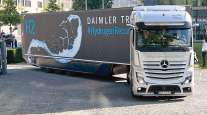Daimler Starts Full Production of AMTs for North America
This story appears in the May 6 print edition of Transport Topics.
GAGGENAU, Germany — Daimler Trucks officially began full production of its first automated manual transmissions designed for North American heavy-duty trucks at its plant here last week.
The first DT12 transmissions will go into Freightliner Cascadias beginning May 6 at the Daimler Trucks North America Freightliner plant in Cleveland, N.C., while a new assembly line to produce these transmissions will open in the United States during 2015.
By the time the assembly line opens at DTNA’s Redford plant outside Detroit, it will produce DT12s for the 13-, 15- and 16-liter engines that the company sells throughout North America and will employ some 115 workers.
Daimler officials have said they will invest $120 million in improvements in order to shift the line to the United States.
When the investment was announced, President Obama cited it as an example of how some manufacturing is returning to the United States after a long decline.
“We are very, very satisfied” with DTNA sales in North America, said Frank Reintjes, the head of Daimler Trucks global powertrain, procurement and manufacturing division, and Daimler expects the DT12 to quickly acquire a “good two-digit penetration” of overall Freightliner sales.
Up to now, DTNA has offered AMTs produced only by independent third-party suppliers.
DTNA officials said they are convinced that the superior fuel efficiency produced by the automated manuals will make them a fleet favorite, and they have predicted the AMTs will account for more than 50% of industry sales in North America by 2016.
They estimated that about 15% of new heavy-duty trucks purchased in America during 2012 were AMTs and the rest were manuals; in Europe, they said, the numbers were reversed.
The DT12 is based on an AMT that Daimler first created for its line of heavy-duty trucks in Europe, the Actros, and shares about 90% of the parts from that model. The North American version is designed to run on 12 volts and not the 24 volts that’s the standard in Europe, so the electrical systems are different, as well as some gearing.
AMTs are more efficient because they weigh less and shift gears at the optimum time, officials said. Reintjes added that early test results at fleets using the DT12 show about a 4% fuel-efficiency improvement.
He said the best drivers today can match an AMT’s performance but that the new transmissions allow virtually every driver to come close to the results recorded by the best and most experienced drivers.
The DT12s began rolling through Daimler’s transmission machining factory here on April 29 and through its final assembly plant, located nearby in Rastatt. The company is currently finishing a new assembly line to handle the DT12s in Rastatt, and officials said that it will be copied exactly at the Redford plant.
For now, the DT12s will be offered only for customers who order the Cascadia with the DD15 engine. Officials said they would become available for DD13 customers in October and for DD16 customers in May 2014.
“The Gaggenau facility is the lead plant for all Daimler transmissions globally, so launching our production in Germany allows us to leverage operational efficiencies and production standards,” Reintjes said.
He said the process was similar to what Daimler did when it introduced its new global engine platform at DTNA’s Redford plant and then transferred European production to its plant in Mannheim, Germany, in recent years.
Daimler’s action is similar to what its rival Volvo AB did a year ago when it shifted assembly of its I-shift AMT from Sweden to a plant in Maryland for its Volvo and Mack sales in North America.
These moves are part of a trend by truck makers to produce more of their own major components as they seek an increased share of the total money spent on modern trucks.
Their actions are expected to cut into the business of major independent component makers, such as Eaton Corp., which has been the dominant maker of AMTs for North American customers.
DTNA fleshed out its plans to create a full drivetrain line under its Detroit brand, which was formerly only an engine maker.
In addition to transmissions, Detroit is now selling axles; DTNA used to get most of its axles from Meritor and Dana Corp.
Daimler officials kicked off the production launch with a press conference with journalists from North America who were visiting the plant.
Matthias Jurytko, who heads the plant complex here, said Daimler’s four facilities around Gaggenau employ some 6,430 workers to produce and assemble transmissions for trucks and cars, to produce doors and other assemblies for trucks and cars and to house the company’s international logistics arm.
In all, the plants here produced some 511,000 transmissions during 2012, about 115,000 of which were for trucks.
The Gaggenau plants recently built their 10 millionth transmission, Jurytko said.




